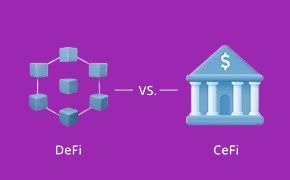In the rapidly evolving world of digital finance, CeFi vs DeFi, CeFi (Centralized Finance) and DeFi (Decentralized Finance) are two dominant models shaping how individuals access and manage financial services. While both aim to improve financial systems, they differ significantly in control, structure, transparency, and user experience. This article dives into a comprehensive comparison between CeFi and DeFi to help you understand which model aligns best with your needs in the crypto-driven economy.
What is CeFi (Centralized Finance)?
CeFi refers to the traditional financial ecosystem where centralized authorities such as banks, brokers, and payment processors manage financial transactions. Users entrust their funds to these institutions, which handle custody, compliance, and services on their behalf.
Key Features of CeFi:
- Operated by central financial entities
- Requires intermediaries to process transactions
- Subject to strict government regulations
- Offers user-friendly interfaces with familiar services
What is DeFi (Decentralized Finance)?
DeFi is a blockchain-powered financial ecosystem that operates without central authorities or intermediaries. It leverages smart contracts on public blockchains (like Ethereum) to facilitate peer-to-peer financial activities such as lending, borrowing, and trading.
Key Features of DeFi:
- Runs on decentralized blockchain networks
- Peer-to-peer interactions with no intermediaries
- Minimal regulatory oversight
- Users maintain full control over their assets
CeFi vs DeFi: Side-by-Side Comparison

| Feature | CeFi | DeFi |
|---|---|---|
| Control | Centralized (banks, institutions) | Decentralized (blockchain, smart contracts) |
| Intermediaries | Required (banks, brokers, processors) | None; peer-to-peer transactions |
| Regulation | Heavily regulated by governments | Lightly regulated or unregulated |
| Security | Institution-managed security | Blockchain-based security; user-controlled |
| Transparency | Limited; often opaque | High; open-source and verifiable |
| Custody | Custodial; institutions hold user funds | Non-custodial; users hold their own keys |
| Fees | High; includes transaction and maintenance fees | Lower; mostly gas/network fees |
| Innovation Speed | Slow due to bureaucracy | Fast due to open development |
| Market Hours | Business hours only | 24/7 global access |
| Systemic Risk | Higher; institutions are interconnected | Lower; distributed systems mitigate contagion |
| User Experience | Simple, beginner-friendly | Varies; requires technical know-how |
| Identity Verification | Mandatory KYC/AML | Optional; pseudonymous or anonymous |
Advantages of CeFi
- Trust and familiarity: Users are accustomed to centralized banks and institutions.
- Customer support: Dedicated help desks and dispute resolution.
- Regulatory compliance: Adheres to financial regulations for security.
Advantages of DeFi
- Full control: Users own their assets and private keys.
- Global access: No barriers; anyone with internet can participate.
- Innovation: Rapid development and new financial products.
- Transparency: Open access to protocols, code, and transactions.
Challenges of CeFi vs DeFi
CeFi Challenges:
- Lack of transparency
- High fees
- Risk of censorship and fund seizure
DeFi Challenges:
- Technical complexity
- Smart contract vulnerabilities
- Regulatory uncertainty
Pros and Cons of CeFi Platforms
Centralized Finance (CeFi) platforms have played a crucial role in bridging the gap between traditional finance and the evolving world of cryptocurrencies. While CeFi offers several conveniences that appeal to mainstream users, it also comes with certain trade-offs that investors must carefully evaluate.
✅ Pros of CeFi Platforms
1. Enhanced Security and Customer Support
Unlike decentralized platforms, CeFi platforms are managed by centralized entities, which means they can offer robust security features including customer service, password recovery, and fraud prevention tools. This makes them more approachable for beginners and less tech-savvy users.
2. User-Friendly Interfaces
CeFi platforms are designed with simplicity in mind. Their intuitive user interfaces make crypto services like buying, lending, and borrowing accessible to a wider audience, including those without a deep understanding of blockchain technology.
3. Higher Yields than Traditional Banks
Many CeFi platforms offer attractive interest rates on crypto savings—far higher than what is typically available through traditional banking institutions. Users can earn passive income on stablecoins, Bitcoin, and other crypto assets.
❌ Cons of CeFi Platforms
1. Trust and Custodianship Risks
With CeFi, users are required to trust a centralized entity to manage and safeguard their funds. Past events—such as the collapse of Celsius, Voyager, BlockFi, and FTX—serve as cautionary tales where millions of dollars were lost due to mismanagement or lack of transparency.
2. Centralized Control and Regulation
CeFi platforms are governed by a single authority and are often subject to strict regulatory oversight. While this adds a layer of compliance, it also introduces potential limitations, account freezes, or restrictions based on jurisdiction.
3. Counterparty Risk
Since your funds are held and managed by the CeFi platform itself, there’s an inherent counterparty risk. Users must trust that the platform remains solvent, secure, and ethical in its operations, especially during periods of market volatility.
CeFi platforms offer the ease, reliability, and higher returns that appeal to mainstream investors. However, they also require users to relinquish control and place trust in centralized providers. Before choosing a platform, always do thorough research, assess the platform’s reputation, and consider diversifying risk between CeFi and DeFi options.
Final Thoughts: Which One is Better?
CeFi vs DeFi isn’t about choosing one over the other—it’s about understanding which suits your goals. If you prioritize security, ease of use, and regulation, CeFi may be the better fit. On the other hand, if you value financial freedom, innovation, and control, DeFi opens a world of possibilities.
FAQs Between CeFi vs DeFi
Q1: Is DeFi safer than CeFi?
DeFi offers transparency and control but depends on smart contract security. CeFi provides regulated protection but requires trusting third parties.
Q2: Can I use both CeFi vs DeFi platforms?
Yes. Many investors use CeFi for stability and DeFi for innovation and higher yields.
Q3: Do I need to verify my identity for DeFi?
Most DeFi platforms do not require KYC, though regulations may change in the future.
